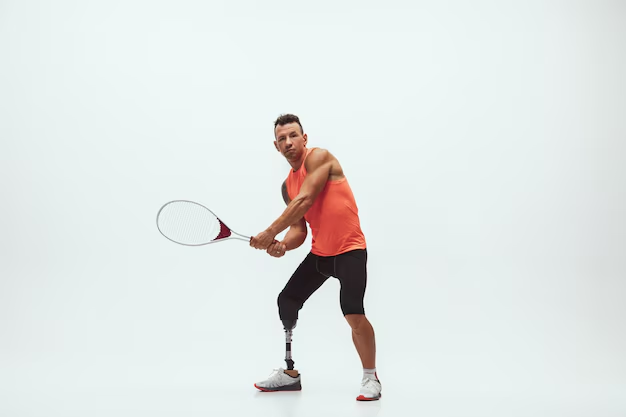Sports have been an integral part of human culture for centuries. From the ancient Olympics to modern-day football leagues, athletics have evolved and adapted to the changing times. One of the most profound transformations in recent years has been the rise of technology in the world of sports. Whether it’s the development of performance-enhancing equipment, data analytics, or even virtual reality training tools, technology is revolutionizing how athletes train, perform, and interact with their fans. The future of athletics is deeply intertwined with innovations in technology, which will continue to shape the way we watch, play, and understand sports.
How Technology is Transforming the World of Sports
1. Advanced Wearable Technology
One of the most exciting advancements in sports technology is the development of wearable devices. Athletes now have access to a wide range of gadgets that track their physical performance in real-time. Devices such as smartwatches, heart rate monitors, and GPS trackers provide valuable data on an athlete’s speed, endurance, and recovery rates. This allows trainers and coaches to assess their athletes’ performance more accurately and make real-time adjustments.
For example, wearables can track how well an athlete is recovering after an intense workout or competition. By monitoring heart rate variability, sleep patterns, and stress levels, wearables help to prevent overtraining, ensuring athletes stay at their peak performance level. This technology is transforming how sports teams manage player health and enhance training regimens.
2. Data Analytics and Performance Monitoring
In modern sports, data is king. Coaches, analysts, and teams are using big data to gain insights into player performance and game strategies. From soccer to basketball, coaches now have access to detailed statistics about players’ movements, shot accuracy, and other performance metrics. This data helps them make better decisions about training, substitutions, and game strategies.
Take the use of performance analytics in football as an example. Using tracking systems like GPS and RFID chips, coaches can analyze how far a player runs during a match, how many sprints they make, and how much time they spend in different zones of the field. This data gives coaches a comprehensive view of player fitness and helps in designing tailored training programs that maximize athletic performance.
3. Virtual Reality (VR) and Augmented Reality (AR) Training
Virtual and augmented reality have moved beyond entertainment and are now being used in sports training. VR technology allows athletes to practice their skills in a simulated environment that mimics real-life scenarios. This is especially useful for sports like football, baseball, or basketball, where athletes can rehearse plays, improve decision-making, and enhance their reaction times without the physical wear and tear.
In golf, VR is being used to analyze swing mechanics, allowing players to improve their techniques before stepping onto the course. Likewise, AR provides an interactive experience where athletes can receive real-time data overlays during training, improving their focus and tactical awareness.
4. Instant Replay and Video Analysis
In recent years, instant replay technology has become a staple in almost every major sport. Whether it’s a goal in soccer, a touchdown in American football, or a home run in baseball, video analysis is helping referees make more accurate calls. Tools like Hawk-Eye in tennis and goal-line technology in soccer have already become essential for ensuring fair play and minimizing human error.
Moreover, coaches and analysts use video analysis to break down every play and move, allowing them to review strategies and make informed decisions. The ability to review high-definition footage of games allows for a deeper understanding of how players perform, helping to identify weaknesses and areas for improvement.
5. Sports Medicine and Injury Prevention
Advancements in sports medicine, particularly with the help of technology, have greatly improved the recovery process for athletes. Techniques like cryotherapy, biomechanical analysis, and regenerative medicine are transforming how injuries are treated and prevented. The use of robotic surgeries and minimally invasive procedures ensures athletes can recover quickly and return to the field with fewer long-term effects.
Additionally, technologies like exoskeletons and biofeedback devices are helping athletes with rehabilitation after serious injuries. These technologies allow athletes to monitor their muscle activity and movement patterns, ensuring they recover with greater precision and speed.
6. Fan Engagement and Virtual Experiences
Technology is also revolutionizing how fans engage with sports. Social media platforms, mobile apps, and online streaming services allow fans to watch games live, access exclusive content, and interact with athletes in real-time. Virtual reality and 360-degree video technology have taken fan engagement to a new level, allowing fans to feel as though they are inside the stadium, even from the comfort of their homes.
For example, some sports teams are experimenting with VR to offer immersive experiences where fans can attend virtual games, making them feel like they’re sitting in the front row. Augmented reality applications also allow fans to view stats, player information, and real-time game updates during live events.
7 Frequently Asked Questions (FAQs) About Technology in Sports
1. How does wearable technology benefit athletes?
Wearable technology allows athletes to track performance metrics like heart rate, distance covered, and calories burned. It helps optimize training, prevent injuries, and improve overall performance.
2. Can data analytics really improve sports performance?
Yes, data analytics provides valuable insights into an athlete’s performance, allowing coaches to design tailored training programs and strategies that improve performance and minimize risk of injury.
3. How is virtual reality used in sports training?
Virtual reality allows athletes to simulate real-world game scenarios, practice specific skills, and improve decision-making without physical exertion. It’s especially useful in contact sports and for practicing precision skills.
4. Does instant replay technology affect the fairness of sports?
Instant replay technology ensures fairness by helping referees make accurate decisions. It minimizes human error, ensuring that important calls, like goals or penalties, are reviewed for accuracy.
5. How does sports medicine technology aid in injury recovery?
Sports medicine technology, such as cryotherapy, biomechanics, and regenerative therapies, speeds up recovery, reduces pain, and helps athletes return to competition faster.
6. Is technology making sports too dependent on gadgets?
While technology enhances training and performance, it’s important that athletes maintain their core skills and instincts. The ideal balance is using technology to supplement, not replace, traditional methods.
7. Will technology make sports more accessible for everyone?
Technology has the potential to make sports more accessible by allowing athletes to train remotely, monitor their progress, and engage with fans from around the world. This can democratize access to sports, especially in underserved regions.
Conclusion
Technology is undoubtedly changing the landscape of sports. From advanced wearables that track every step to virtual reality that refines technique, the future of athletics will continue to be shaped by technological innovations. These advancements not only enhance the performance of athletes but also improve fan engagement and make sports more accessible and enjoyable for everyone.
Key Takeaways
- Wearable Tech: Devices that monitor performance, recovery, and health metrics are revolutionizing how athletes train and perform.
- Big Data and Analytics: Data-driven insights help coaches and athletes make informed decisions about training, performance, and strategy.
- Virtual and Augmented Reality: VR and AR are transforming training by allowing athletes to practice skills in simulated environments and improve game strategies.
- Injury Prevention: Advances in sports medicine and rehabilitation technology ensure faster recovery and better prevention of injuries.
- Fan Interaction: Technology is enhancing fan engagement through virtual experiences, real-time data, and social media, making sports more immersive and interactive.

